Although I finished this model some time ago, I thought I would post it here as it was an interesting research project. This is my interpretation of the aircraft (L1842) flown by PO Mould when he scored the first RAF victory over France on Oct 30, 1939
Although shown in a couple of references as being coded "G" (as well as in the 1/48 Classic Airframes kit and 1/32 Montex mask set), this is likely not the case as "G" was a different aircraft that was flown by PO Richey. Research and assistance from several other modelers on various forums turned up photos of what is likely L1842. This aircraft was written off in France when Sgt A.V. Clowes (of JX-B with wasp fame), who had borrowed Mould's L1842 was hit in the tail by a French Hawk 75 while attacking German bombers. Clowes crash landed the aircraft without injury. Below is a photo of Clowes posing in front of the crashed aircraft as well as another of it showing the damage to the tail, which both show the aircraft being coded "T" rather than "G":
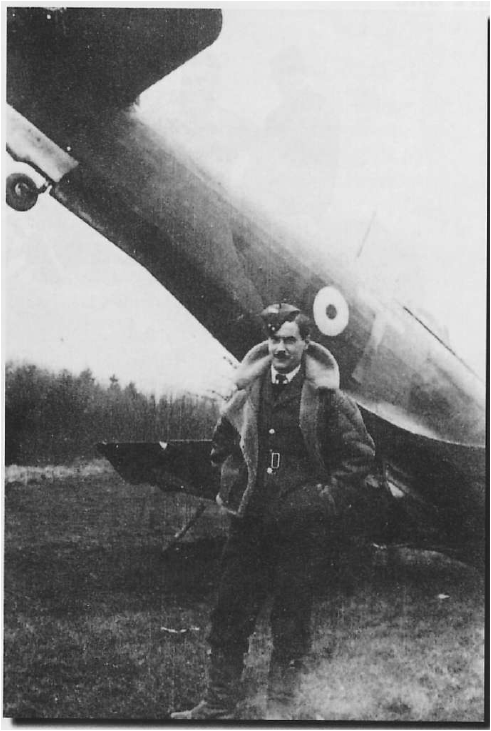
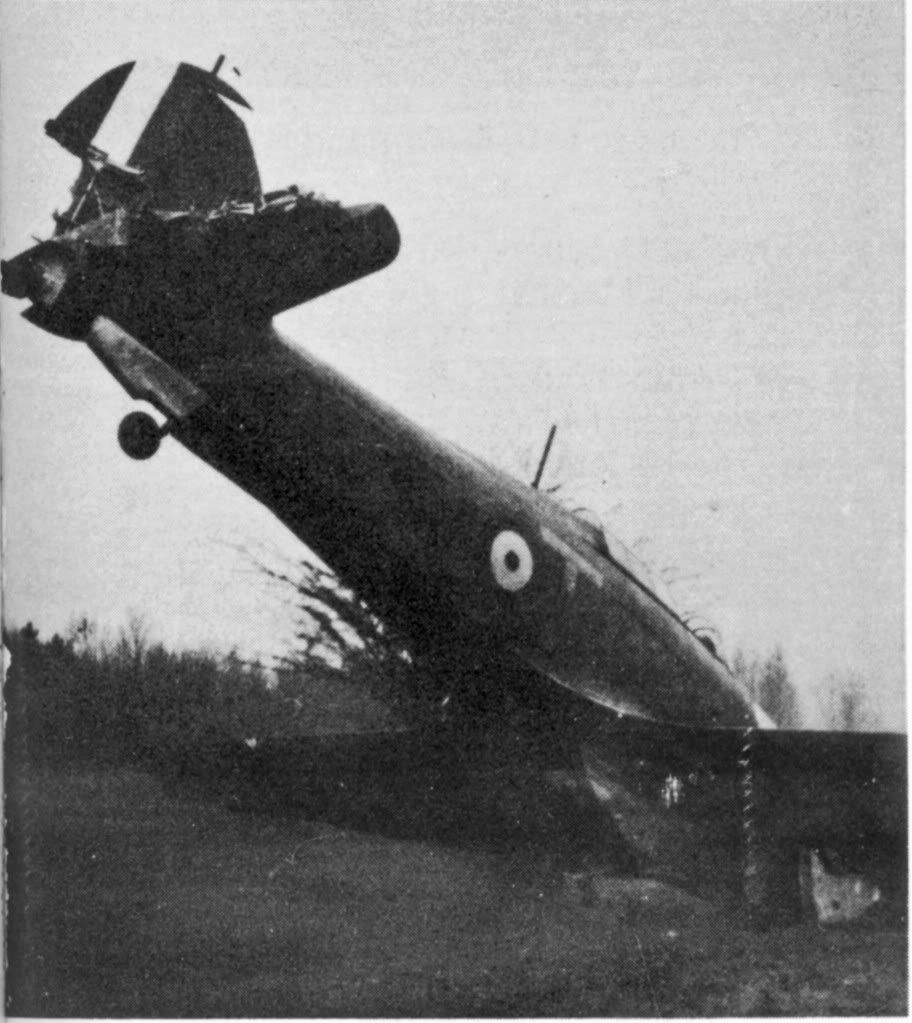
Additional circumstantial evidence that "T" is indeed the correct code for L1842.
We have a loss report, where Mould, flying a replacement Hurri, coded "T", took some fire from a Do17 while attacking it:
It would make sense that if his *regular* aircraft were coded "T", the replacement would recieve the same code letter.
Finally, when CO of No.185 squadron, Mould, who should likely have flown "A", still flew "T":
This evidence, in combination with the above photos of Clowes in front of the damaged Hurri, is enough to convince me that L1842 was coded "T".
The other area to figure out was the bottom of the fuselage, and, after looking at dozens and dozens of photos, I decided my best guess was silver dope for the nose and tail (with black white wings) with fluid staining causing it to appear dark (with a replacement tail section in white/black from the tailwheel back). In many B/W photos, silver dope looks very dark, almost black, on the undersides of parked aircraft. There is a nice photo of a fabric winged Hurri in Yugoslavian markings on a test flight that is banking away from the camera. Even at this early point in it's life, there is significant fluid leaking (I assume oil) from the inner flap area and streaking back onto the fuselage, as well as the standard oil leaking from the cowl area. I have tried to replicate this on my model.
By all accounts Vassicourt was a pretty muddy place when No. 1 squadron was there, so I have added some mud splatters as well to the bottom and lower rudder and muddied up the wheels.
Here are a couple of snaps of my PCM Hurri done up as Mould's aircraft after scoring the first RAF victory over continental Europe in WW2:


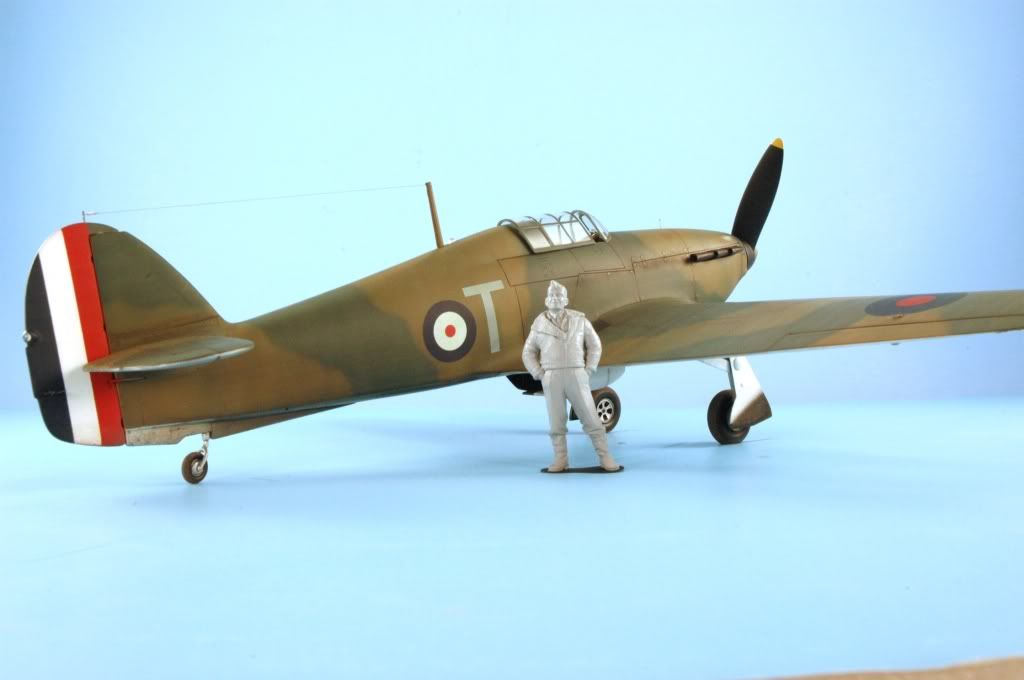
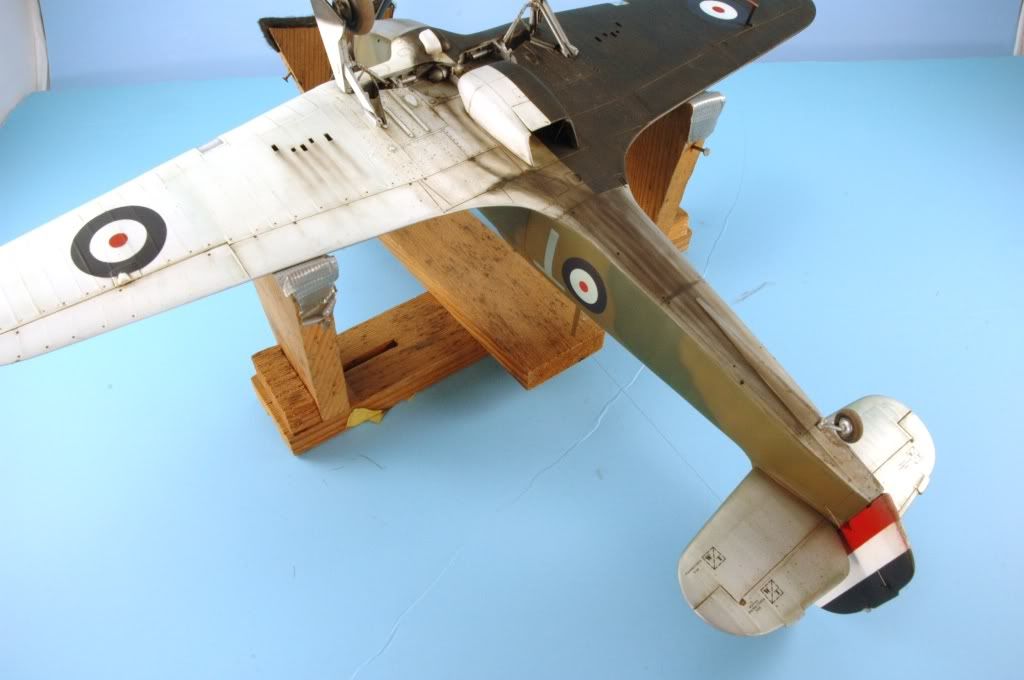
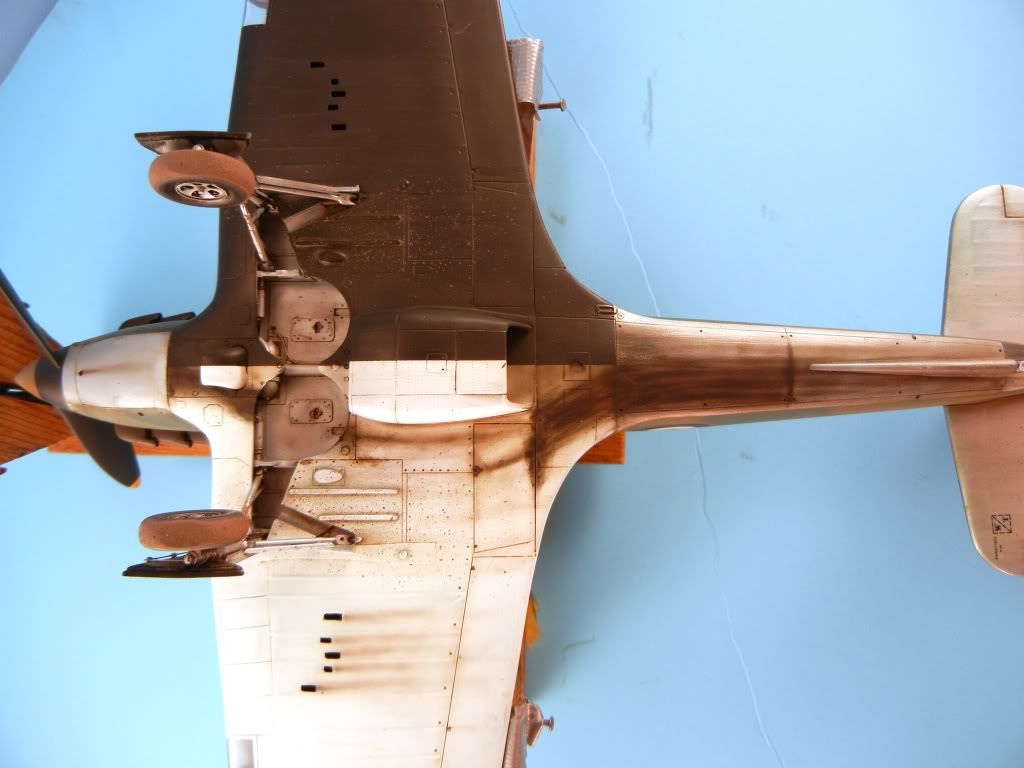
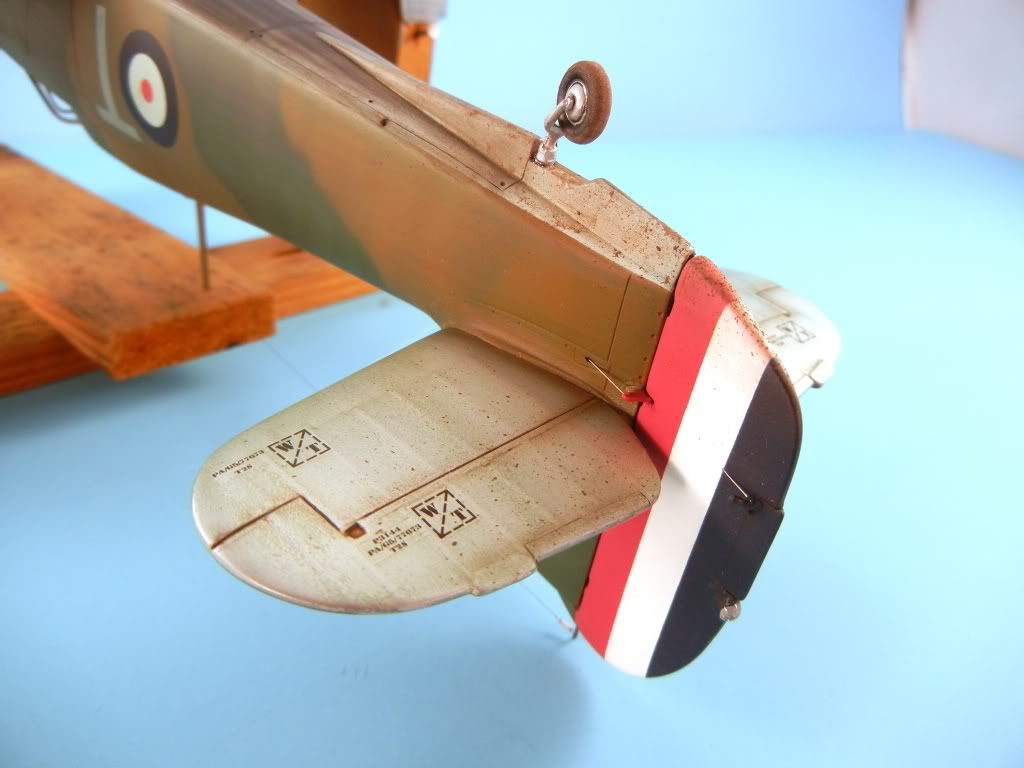
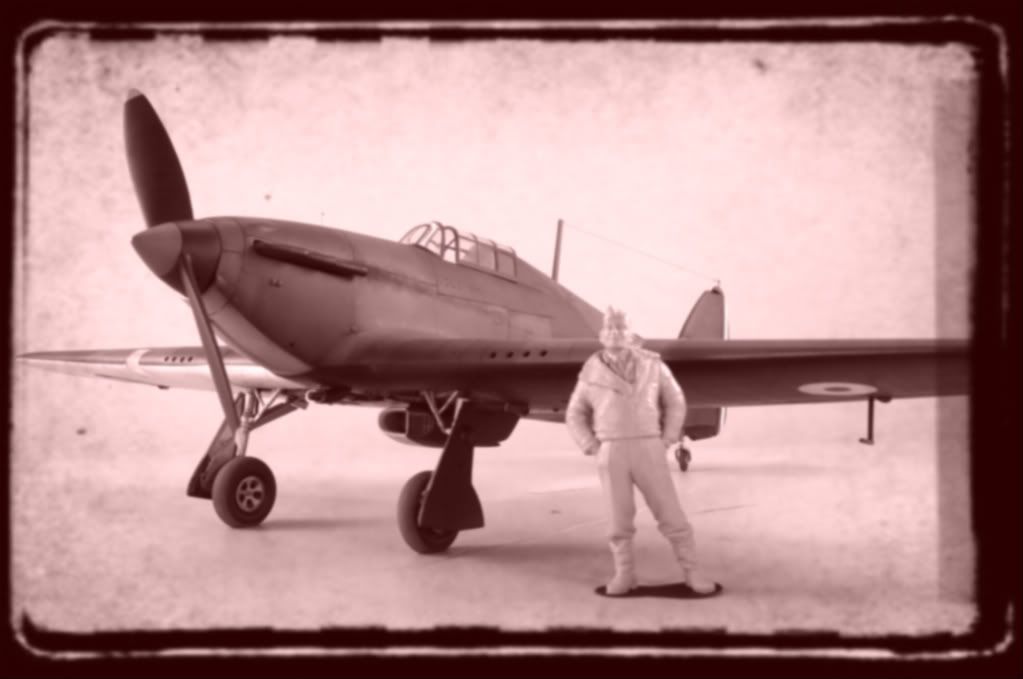
Comments/criticism/questions welcome!
Cheers,
Doug
Although shown in a couple of references as being coded "G" (as well as in the 1/48 Classic Airframes kit and 1/32 Montex mask set), this is likely not the case as "G" was a different aircraft that was flown by PO Richey. Research and assistance from several other modelers on various forums turned up photos of what is likely L1842. This aircraft was written off in France when Sgt A.V. Clowes (of JX-B with wasp fame), who had borrowed Mould's L1842 was hit in the tail by a French Hawk 75 while attacking German bombers. Clowes crash landed the aircraft without injury. Below is a photo of Clowes posing in front of the crashed aircraft as well as another of it showing the damage to the tail, which both show the aircraft being coded "T" rather than "G":


Additional circumstantial evidence that "T" is indeed the correct code for L1842.
We have a loss report, where Mould, flying a replacement Hurri, coded "T", took some fire from a Do17 while attacking it:
Type: Hurricane Mk 1
Serial number: P2649, JX-T
Operation: Patrol
Damaged: 10/05/1940
P/O W.O. Mould - unhurt
Took off from Vassincourt. Hit by return fire from Do 17 engaged east of rouvres 05.00 hrs. Returned with slight damage and punctured tyre. Aircraft damaged but repairable.
* from Fighter Command Losses, Vol 1, 1939-1941, Norman L.R. Franks
Serial number: P2649, JX-T
Operation: Patrol
Damaged: 10/05/1940
P/O W.O. Mould - unhurt
Took off from Vassincourt. Hit by return fire from Do 17 engaged east of rouvres 05.00 hrs. Returned with slight damage and punctured tyre. Aircraft damaged but repairable.
* from Fighter Command Losses, Vol 1, 1939-1941, Norman L.R. Franks
It would make sense that if his *regular* aircraft were coded "T", the replacement would recieve the same code letter.
Finally, when CO of No.185 squadron, Mould, who should likely have flown "A", still flew "T":
Date: 1st October 1941
Unit: No.185 Squadron
Type: Hawker Hurricane IIb
Serial. Z5265
Code: - T
Location: Missing north of Gozo, off Malta.
Pilot: Pilot Officer Peter William Olber Mould 33414 Age: 24 Killed
* from aircrew rememberance society webpage (www.aircrewremembrancesociety.com/raf1941/mould.html)
In Hurricanes over Malta by Brian Cull, there is a picture of Mould's Hurricane Z5265. Only the letter 'T' is painted on, not the 'GL'.
Unit: No.185 Squadron
Type: Hawker Hurricane IIb
Serial. Z5265
Code: - T
Location: Missing north of Gozo, off Malta.
Pilot: Pilot Officer Peter William Olber Mould 33414 Age: 24 Killed
* from aircrew rememberance society webpage (www.aircrewremembrancesociety.com/raf1941/mould.html)
In Hurricanes over Malta by Brian Cull, there is a picture of Mould's Hurricane Z5265. Only the letter 'T' is painted on, not the 'GL'.
This evidence, in combination with the above photos of Clowes in front of the damaged Hurri, is enough to convince me that L1842 was coded "T".
The other area to figure out was the bottom of the fuselage, and, after looking at dozens and dozens of photos, I decided my best guess was silver dope for the nose and tail (with black white wings) with fluid staining causing it to appear dark (with a replacement tail section in white/black from the tailwheel back). In many B/W photos, silver dope looks very dark, almost black, on the undersides of parked aircraft. There is a nice photo of a fabric winged Hurri in Yugoslavian markings on a test flight that is banking away from the camera. Even at this early point in it's life, there is significant fluid leaking (I assume oil) from the inner flap area and streaking back onto the fuselage, as well as the standard oil leaking from the cowl area. I have tried to replicate this on my model.
By all accounts Vassicourt was a pretty muddy place when No. 1 squadron was there, so I have added some mud splatters as well to the bottom and lower rudder and muddied up the wheels.
Here are a couple of snaps of my PCM Hurri done up as Mould's aircraft after scoring the first RAF victory over continental Europe in WW2:







Comments/criticism/questions welcome!
Cheers,
Doug


